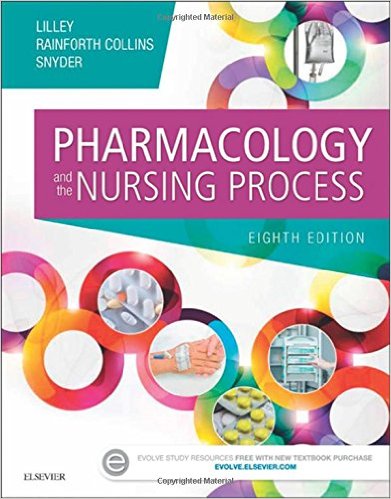Test Bank For Pharmacology And The Nursing Process 8 Edition by Linda Lane-Collins -Julie S. Snyder
Digital item No Waiting Time Instant DownloadISBN-10 : 0323358284 ISBN-13 : 978-0323358286
In Stock
Original price was: $75.00.$30.00Current price is: $30.00.
Test Bank For Pharmacology And The Nursing Process 8 Edition by Linda Lane-Collins -Julie S. Snyder
Chapter 02: Pharmacologic PrinciplesLilley: Pharmacology and the Nursing Process, 8th Edition MULTIPLE CHOICE 1. The patient is receiving two different drugs. At current dosages and dosage forms, both drugs are absorbed into the circulation in identical amounts. Which term is used to identify this principle?a.Bioequivalentb.Synergisticc.Prodrugsd.Steady state ANS: ATwo drugs absorbed into the circulation in the same amount (in specific dosage forms) have the same bioavailability; thus, they are bioequivalent. A drug’s steady state is the physiologic state in which the amount of drug removed via elimination is equal to the amount of drug absorbed from each dose. The term synergistic refers to two drugs, given together, with a resulting effect that is greater than the sum of the effects of each drug given alone. A prodrug is an inactive drug dosage form that is converted to an active metabolite by various biochemical reactions once it is inside the body. DIF: COGNITIVE LEVEL: Understanding (Comprehension) REF: p. 21TOP:NURSING PROCESS: ImplementationMSC: NCLEX: Physiological Integrity: Pharmacological and Parenteral Therapies 2. When given an intravenous medication, the patient says to the nurse, “I usually take pills. Why does this medication have to be given in the arm?” What is the nurse’s best answer?a.“The medication will cause fewer adverse effects when given intravenously.”b.“The intravenous medication will have delayed absorption into the body’s tissues.”c.“The action of the medication will begin sooner when given intravenously.”d.“There is a lower chance of allergic reactions when drugs are given intravenously.” ANS: CAn intravenous (IV) injection provides the fastest route of absorption. The IV route does not affect the number of adverse effects, nor does it cause delayed tissue absorption (it results in faster absorption). The IV route does not affect the number of allergic reactions. DIF: COGNITIVE LEVEL: Understanding (Comprehension) REF: p. 22TOP:NURSING PROCESS: ImplementationMSC: NCLEX: Physiological Integrity: Pharmacological and Parenteral Therapies 3. The nurse is administering parenteral drugs. Which statement is true regarding parenteral drugs?a.Parenteral drugs bypass the first-pass effect.b.Absorption of parenteral drugs is affected by reduced blood flow to the stomach.c.Absorption of parenteral drugs is faster when the stomach is empty.d.Parenteral drugs exert their effects while circulating in the bloodstream. ANS: ADrugs given by the parenteral route bypass the first-pass effect. Reduced blood flow to the stomach and the presence of food in the stomach apply to enteral drugs (taken orally), not to parenteral drugs. Parenteral drugs must be absorbed into cells and tissues from the circulation before they can exert their effects; they do not exert their effects while circulating in the bloodstream. DIF: COGNITIVE LEVEL: Understanding (Comprehension) REF: p. 22TOP:NURSING PROCESS: GeneralMSC: NCLEX: Physiological Integrity: Pharmacological and Parenteral Therapies 4. When monitoring the patient receiving an intravenous infusion to reduce blood pressure, the nurse notes that the patient’s blood pressure is extremely low, and the patient is lethargic and difficult to awaken. This would be classified as which type of adverse drug reaction?a.Adverse effectb.Allergic reactionc.Idiosyncratic reactiond.Pharmacologic reaction ANS: DA pharmacologic reaction is an extension of a drug’s normal effects in the body. In this case, the antihypertensive drug lowered the patient’s blood pressure levels too much. The other options do not describe a pharmacologic reaction. An adverse effect is a predictable, well-known adverse drug reaction that results in minor or no changes in patient management. An allergic reaction (also known as a hypersensitivity reaction) involves the patient’s immune system. An idiosyncratic reaction is unexpected and is defined as a genetically determined abnormal response to normal dosages of a drug. DIF: COGNITIVE LEVEL: Understanding (Comprehension) REF: p. 32TOP:NURSING PROCESS: GeneralMSC: NCLEX: Physiological Integrity: Pharmacological and Parenteral Therapies 5. The nurse is reviewing pharmacology terms for a group of newly graduated nurses. Which sentence defines a drug’s half-life?a.The time it takes for the drug to cause half of its therapeutic responseb.The time it takes for one half of the original amount of a drug to reach the target cellsc.The time it takes for one half of the original amount of a drug to be removed from the bodyd.The time it takes for one half of the original amount of a drug to be absorbed into the circulation ANS: CA drug’s half-life is the time it takes for one half of the original amount of a drug to be removed from the body. It is a measure of the rate at which drugs are removed from the body. The other options are incorrect definitions of half-life. DIF: COGNITIVE LEVEL: Understanding (Comprehension) REF: p. 27TOP:NURSING PROCESS: GeneralMSC: NCLEX: Physiological Integrity: Pharmacological and Parenteral Therapies


Reviews
There are no reviews yet.